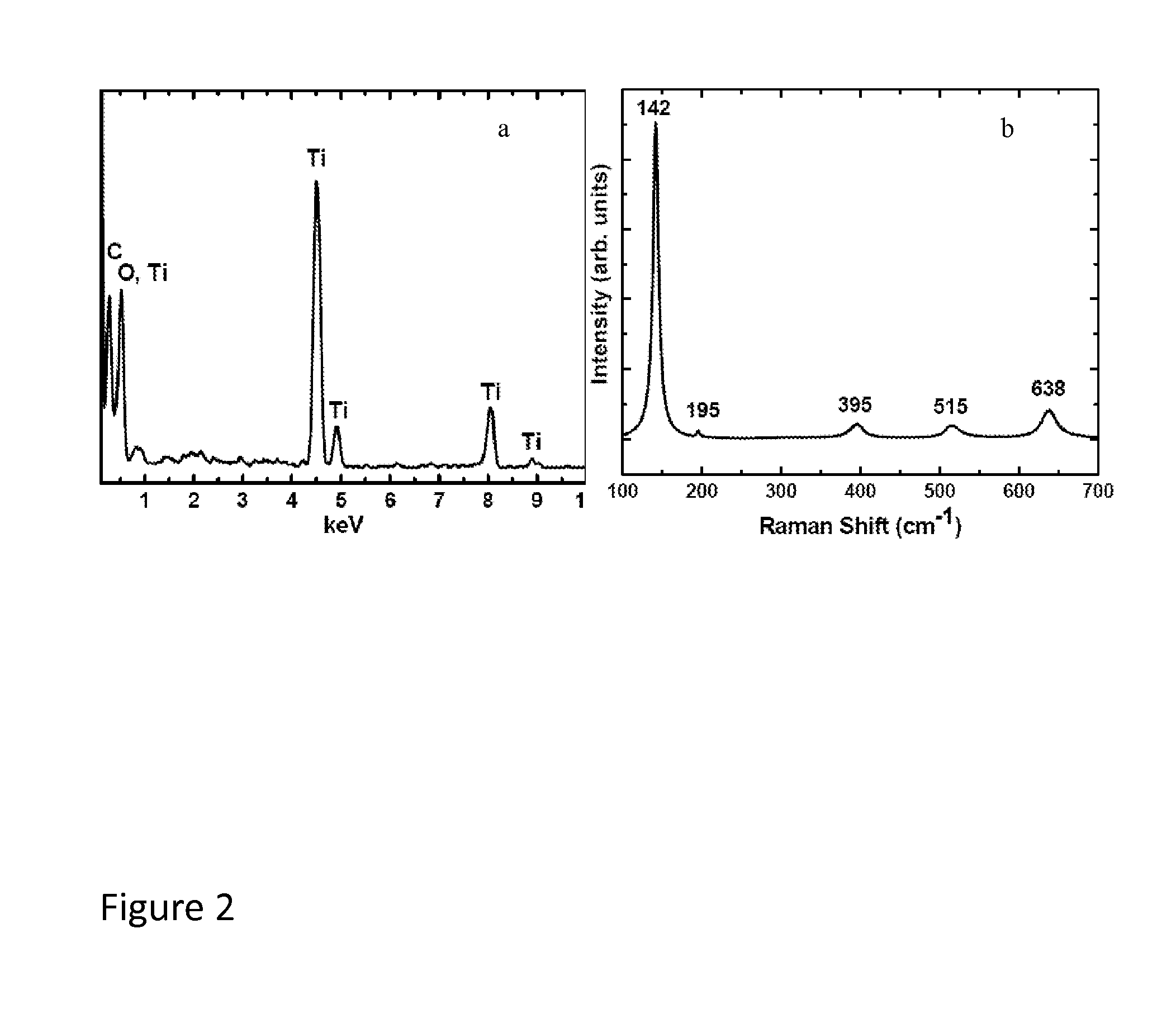Autogenic reaction synthesis of photocatalysts for solar fuel generation
a photocatalytic and solar fuel technology, applied in the direction of metal/metal-oxide/metal-hydroxide catalysts, lanthanide oxides/hydroxides, bulk chemical production, etc., can solve the problems of high environmental cost of burning coal, high inefficiency of photocatalytic reduction of carbon dioxide, and inefficient conversion. remained a significant impedimen
- Summary
- Abstract
- Description
- Claims
- Application Information
AI Technical Summary
Benefits of technology
Problems solved by technology
Method used
Image
Examples
example 1
TiO2 (Anatase) Before and After Removal of Carbon Coating
[0035]Carbon-encapsulated anatase TiO2 nanoparticles were prepared by thermolysis of a single precursor, titanium (IV) oxyacetyl acetonate (TiO[C5H8O2]2), in a sealed reactor (Haynes 230 alloy, 10 mL capacity) fitted with a pressure gauge. Two grams of the precursor material were placed in the reactor under a nitrogen atmosphere. After being tightly sealed, the reactor was placed in a furnace and heated to 700° C. at a heating rate of 30° C. / minute. The temperature of the reactor was held at 700° C. for 1 hour, during which a maximum autogenic pressure of 150 psi (10.2 atm) was reached. Thereafter, the reactor was cooled gradually to room temperature, and the remaining pressure was released before it was opened to collect the product (a black powder). A thermogravimetric analysis (TGA, Seiko Exstar 6000) of the resulting black powder revealed that the as-prepared TiO2 product contained approximately 30% carbon by weight (i.e.,...
example 2
Composition and Structure of Anatase TiO2 Photocatalyst
[0038]An elemental analysis of the substantially carbon-free TiO2 nanoparticle material of Example 1, obtained by energy dispersive x-ray spectroscopy (EDS), showed only C, O, and Ti, confirming the purity of the TiO2 produced as described herein. The small presence of carbon (inset in FIG. 2a) is primarily due to the supported sample grid. A Raman spectrum of the TiO2 same product, exhibited the strongest band at 142 cm−1 and additional bands at 195, 395, 515, and 638 cm−1, which is characteristic of pure anatase TiO2. It has been reported that the phase transformation of pure anatase to rutile occurs at around 600° C. Thus, the Raman data demonstrate that the TiO2 particles formed under the autogenic reaction conditions described herein surprisingly remained in the anatase phase even though the reaction temperature (about 700° C.) was about 100 degrees higher than the reported phase transition temperature for conversion of ana...
example 3
SnO2 Nanoparticles: Before and After Removal of Carbon Coating
[0039]Carbon-coated SnO2 nanoparticles were prepared by thermolysis of a single precursor, tin ethoxide, Sn(OC2H5)2, in a the same autogenic reactor setup used in Example 1. After being tightly sealed, the pressure gauge of the reactor was attached and the reactor was placed in a furnace to heat up to about 600° C. with a heating rate of about 20° C. / minute. The temperature of the reactor was held at 600° C. for 1 hour, during which time a maximum autogenic pressure of about 100 psi was reached. Thereafter, the reactor was cooled gradually to room temperature (over about 4 hours), and the remaining pressure was released before the reactor was opened to afford carbon-coated SnO2 nanoparticles (SnO2—C) as a black powder. A sample of the carbon-coated material was heated in air at about 450° C. to remove the carbon coating as in Example 1.
[0040]The particle diameters and structure of the SnO2—C and SnO2 particles were studie...
PUM
| Property | Measurement | Unit |
|---|---|---|
| temperature | aaaaa | aaaaa |
| temperature | aaaaa | aaaaa |
| particle size | aaaaa | aaaaa |
Abstract
Description
Claims
Application Information
 Login to View More
Login to View More - R&D
- Intellectual Property
- Life Sciences
- Materials
- Tech Scout
- Unparalleled Data Quality
- Higher Quality Content
- 60% Fewer Hallucinations
Browse by: Latest US Patents, China's latest patents, Technical Efficacy Thesaurus, Application Domain, Technology Topic, Popular Technical Reports.
© 2025 PatSnap. All rights reserved.Legal|Privacy policy|Modern Slavery Act Transparency Statement|Sitemap|About US| Contact US: help@patsnap.com



